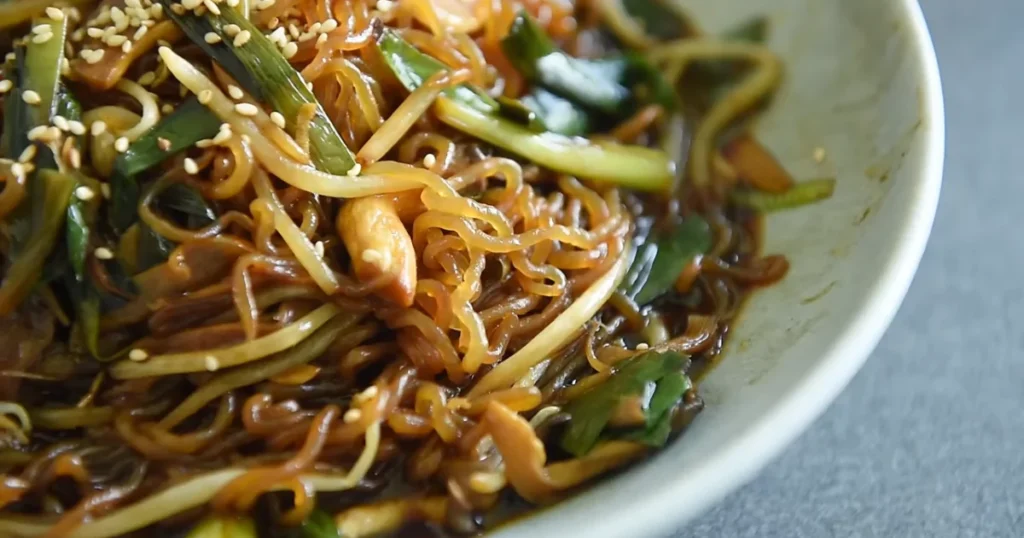Looking for a fulfilling, low-carb meal that’s perfect for a keto eating regimen and filled with flavor? This Stir-Fry Shirataki Noodles Recipe is your answer! Made with konjac noodles (additionally called shirataki noodles), this dish is a wholesome, high-fiber stir-fry that’s both gluten-loose and best for weight reduction. With just a few simple substances, you’ll have a keto-friendly shirataki noodle stir-fry with veggies that’s smooth to make and complete with nutrients. Perfect for brief meal prep or a weeknight dinner, this recipe will satisfy your cravings for noodles without the carbs. Try this versatile, healthy shirataki noodle stir-fry for a delicious manner to experience a nutritious, low-calorie dish!

What Are The Stir Fry Shirataki Noodles?
Stir-Fry Shirataki Noodles are thin, translucent noodles crafted from the konjac root, a plant local to Asia. The noodles are composed by and large of water and a soluble fiber referred to as glucomannan, making them very low in calories and carbohydrates. Often referred to as “miracle noodles,” Shirataki has grown to be famous worldwide as a low-carb, keto-pleasant, and gluten-free alternative to standard pasta and noodles.
How Are Shirataki Noodles Used?
Shirataki noodles are extraordinarily flexible and can be utilized in lots of dishes. Commonly, they’re brought to stir-fries, soups, salads, or even pasta-style dishes as a substitute for conventional noodles. In Japan, they are historically utilized in warm pot dishes like sukiyaki and shabu-shabu. Their impartial flavor allows them to take on the flavor of the sauces, broths, or seasonings used in a recipe.

Are Stir-Fry Shirataki Noodles Used Worldwide?
Yes, shirataki noodles have won a worldwide reputation because of their fitness blessings. Originally famous in Japan and East Asia, they’re now broadly available in Western nations just like the United States, Canada, and parts of Europe. They are also discovered in nations like Australia, and New Zealand, and in urban regions across the Middle East. Thanks to online marketplaces, shirataki noodles can be without difficulty ordered globally, making them reachable to human beings following low-carb, diabetic, gluten-free, or vegan diets.

What Do Shirataki Noodles Taste Like?
Shirataki noodles are impartial in flavor however have a completely unique, chewy texture that absorbs the flavor of sauces or seasonings well. They don’t taste like traditional pasta but as an alternative have a moderate flavor that adapts easily to the substances they’re cooked with. Their initial aroma (a barely fishy scent) may be rinsed away, making them greater palatable.

Health Benefits of Shirataki Noodles
- Low Calorie and Low Carb: Shirataki noodles have the most effective 10-20 calories in line with serving, making them an amazing option for weight management.
- High in Fiber: The glucomannan fiber in shirataki noodles promotes emotions of fullness, which can reduce typical calorie consumption.
- Blood Sugar Regulation: Glucomannan slows digestion and facilitates to prevention of rapid spikes in blood sugar, making it useful for diabetics.
- Supports Digestive Health: The fiber in shirataki noodles acts as a prebiotic, supporting intestine fitness through feeding useful bacteria.
- Gluten-Free and Vegan: These noodles are naturally gluten-unfastened and plant-based, catering to specific nutritional restrictions.

Customizing the Shirataki Stir-Fry Recipe
Shirataki noodle stir-fry may be easily customized to match different tastes or dietary wishes. Here are some thoughts:
- Make It Spicy: Add a dash of sriracha or chili flakes for warmth.
- Add More Flavor: Try the use of one-of-a-kind sauces like hoisin, teriyaki, or coconut aminos for variety.
- Use Different Proteins: Swap tofu or bird with shrimp, pork, or even tempeh.
- Experiment with Veggies: Use any greens you have handy, including broccoli, zucchini, or mushrooms.
- Top with Herbs: Add a sprinkle of fresh cilantro, basil, or mint for added flavor.
How Many Varieties of Shirataki Noodles Are There?
Shirataki noodles come in numerous bureaucracy and shapes, including:
- Traditional Shirataki Noodles: Thin and translucent, resembling glass noodles.
- Fettuccine Style: Flat and wide noodles, perfect for pasta-style dishes.
- Rice Shape: Small, round portions such as rice, often used as a low-carb rice substitute.
- Angel Hair: Thinner noodles that work well in soups and lighter dishes.
- Tofu Shirataki: A variant that includes tofu for a barely firmer texture and brought protein.


Shirataki Noodles for a Delicious Stir-Fry
Ingredients
- 400 g shirataki or 2 packets of each 200g
- 2-3 pieces garlic
- 60 g Chinese chives
- small piece ginger
- 75 g oyster mushrooms
- 1 1/2 tbsp soy sauce
- 1 tsp dark soy sauce
- 1 tsp black vinegar (or rice vinegar)
- 1 tbsp maple syrup
- 2 tbsp chili oil
- 1/2 tsp crushed chili flakes (optional)
- 75g bean sprouts
- 1/2 tbsp potato starch + 1 tbsp water
- 1/2 tsp white sesame seeds
Instructions
- Rinse and drain the shirataki and set aside

- Thinly slice the garlic and chop the Chinese chives into bite sized pieces

- Chop the ginger into thin matchsticks.

- Tear the oyster mushrooms into bite sized pieces

- Make the stir fry sauce by combining the soy sauce, dark soy sauce, black vinegar, and maple syrup

- Heat up a nonstick pan to medium heat.
- Add the oyster mushrooms and dry sauté for 4-5min. Set the mushrooms aside
- Heat the pan to medium low.
- Add the chili oil followed by the garlic, ginger, and optional crushed chili flakes. Cook for about 2-3min
- Add the Chinese chives and turn the heat to medium. Cook for another couple of minutes
- Add the oyster mushrooms, bean sprouts, and shirataki. Give the stir fry sauce a stir and add onto the shirataki. Sauté for a couple of minutes
- Make a slurry by combining the potato starch and water together. Pour the slurry into the pan and give it a good stir

- Plate and sprinkle over some white sesame seeds to serve

What do shirataki noodles flavor like?
Shirataki noodles have an impartial flavor and take at the flavor of the sauces or seasonings used in the dish. Their texture is barely chewy, which some human beings evaluate as rice noodles or glass noodles.
Why do shirataki noodles have a fishy scent, and how do I dispose of them?
The odor comes from the water they’re packed in, not the noodles themselves. Rinse them thoroughly under cold water for a few minutes to take away this smell, and pat them dry. You also can dry-fry them in a pan to in addition enhance the texture and eliminate any closing odor.
Can I use shirataki noodles in the area of pasta?
Yes, shirataki noodles can be used as a low-carb pasta opportunity. However, they have an exclusive texture than wheat-primarily based pasta. They work properly with flavorful sauces that assist mask the neutral taste.
Are shirataki noodles zero-calorie?
Most shirataki noodles have approximately 10-20 energy in step with serving, which may be very low compared to traditional noodles or pasta. The glucomannan fiber inside the noodles makes them filling, in spite of minimal energy.
Can I meal-prep this shirataki noodle stir-fry?
Yes, shirataki noodle stir-fry can be meal-prepped. However, to keep the feel fresh, don’t forget to store the cooked noodles one by one from the greens and protein and then reheat them collectively.
What are some substitutes for soy sauce if I’m gluten-sensitive?
You can use tamari or coconut aminos as a gluten-loose opportunity to soy sauce. These alternatives will still provide a rich, savory flavor to the stir-fry.
Can I freeze shirataki noodles?
Shirataki noodles don’t freeze properly, as freezing can have an effect on their texture. It’s satisfactory to store them in the refrigerator and devour them within some days.
Are shirataki noodles suitable for a keto food plan?
Yes, shirataki noodles are keto-pleasant. They’re extraordinarily low in carbohydrates, making them perfect for the ones following a ketogenic or low-carb diet.
What vegetables work fine with shirataki noodle stir-fry?
Bell peppers, snap peas, carrots, broccoli, mushrooms, and zucchini are splendid options. However, any brief-cooking greens may be added to fit your flavor.
Visit Our Site
For more recipes, visit our site.












